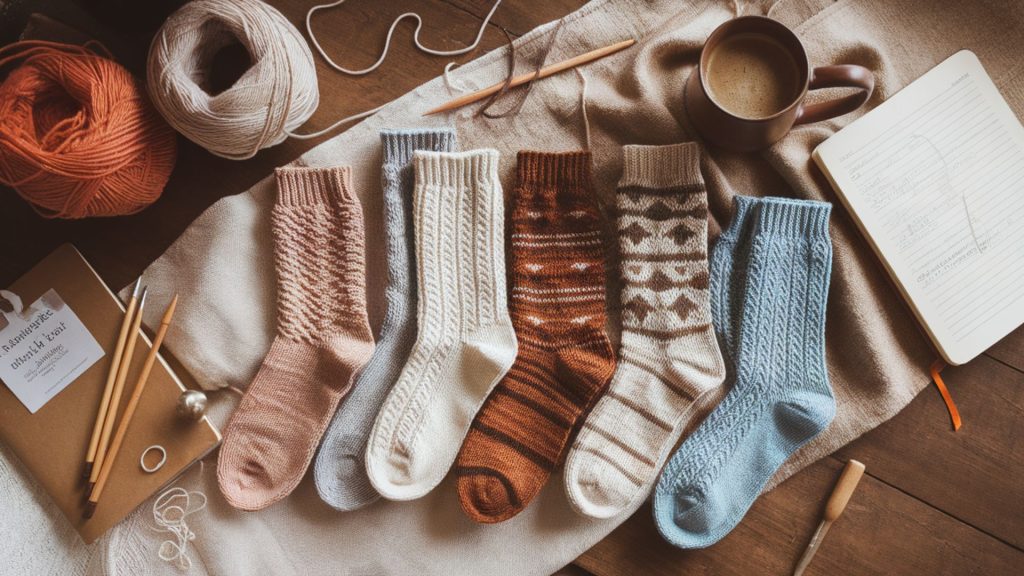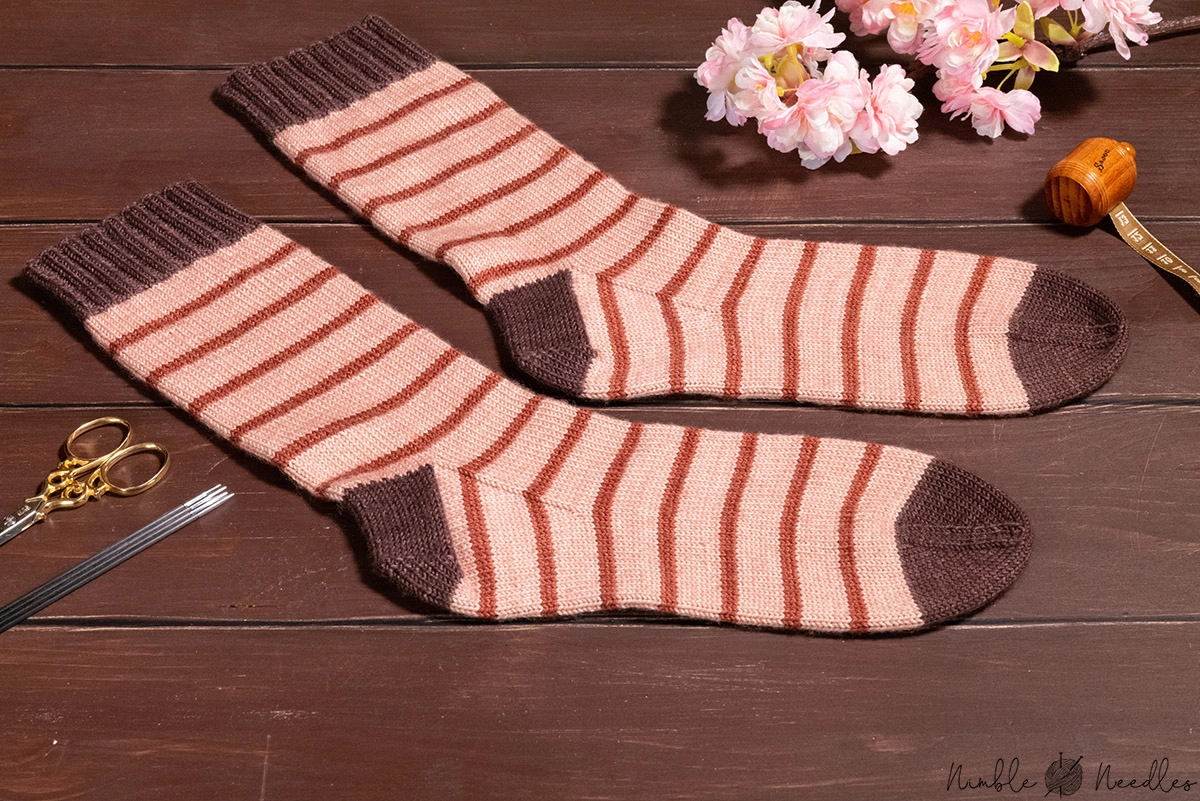Ever stared at your feet and thought, “These socks could be more exciting”? I get it. After knitting hundreds of pairs and teaching sock-making for eight years, I’ve learned what works and what doesn’t.
In this guide, I’ll walk you through 15 tested sock patterns that range from beginner-friendly stripes to eye-catching cable designs.
You’ll discover how to choose the right yarn, master basic techniques, and add your personal touch to each pattern.
I remember the frustration of following complicated patterns that left me with misshapen socks. That’s why each design here comes with clear steps, troubleshooting tips, and photos of crucial details.
Whether you’re making cozy winter socks or lightweight summer ones, you’ll find patterns that match your style and skill level.
Let’s turn those boring socks into conversation starters.
Why Sock Patterns Matter
You might think socks are just things you put on your feet. I used to think the same way. Then, I discovered the joy of patterned socks.
1. The Hidden Benefits
Good patterns do more than make your socks look nice. They help your socks fit better and last longer. Think about it – when was the last time you felt truly excited about your socks?
2. Practical Advantages
The right pattern can
- Stop your socks from sliding down
- Make the heel fit perfectly
- Keep your feet warm without being too thick
- Add strength to high-wear areas
3. The Technical Side
Here’s something most people don’t know: Patterns affect how the yarn works. They can make your sock stretch in just the right places. They can add cushioning where you need it most.
4. The Fun Factor
But let’s be real. Sometimes, you just want your socks to make you smile. Maybe it’s a subtle pattern that peeks out above your shoes. Or a bold design that shows off your personality.
5. Popular Sock Patterns
When I first started knitting socks, I was overwhelmed by all the pattern choices. Now, after years of testing different designs, I can share the ones that truly stand out.
6. Classic Ribbing
Simple but effective. The basic rib pattern isn’t just traditional – it’s a workhorse. It hugs your leg just right and rarely loses its shape. Perfect for your first pair of socks.
7. Cable Twists
Think of cables as braids in your socks. They look fancy but aren’t as hard as you might think. These patterns add texture and warmth without bulk.
8. Eye of Partridge
My personal favorite for heels. This diamond-like pattern adds cushioning and strength where you need it most. Plus, it looks impressive, even in solid colors.
9. Zigzag Lace
Don’t let the name scare you. These airy patterns create tiny holes in a zigzag pattern. They’re perfect for summer socks and dress shoes.
10. Color Work
Whether it’s stripes, dots, or fair isles, playing with colors can transform basic socks into wearable art. Start simple with two colors – you can always add more later.
Remember, the best pattern is one you’ll enjoy knitting and wearing. Sometimes, that’s a complex design, and sometimes, it’s just good old ribbing.
Choosing the Right Sock Pattern
Not every pattern works for every situation. I’ve learned this the hard way after making socks that looked great but felt wrong.
1. Consider Your Lifestyle
Think about where you’ll wear these socks. Thick cable patterns might feel too bulky in dress shoes. Delicate lace designs might not hold up to hiking boots.
2. Skill Level Matters
The truth is that some patterns need more attention than others. Here’s what to expect
- Beginner: Ribbing, simple stripes, basic texture patterns.
- Intermediate: Cables, basic lace, two-color designs.
- Advanced: Complex colorwork, intricate lace, multiple pattern combinations.
3. Yarn Makes a Difference
Your yarn choice can make or break a pattern. Variegated yarns can hide complex stitch patterns. Solid colors show off texture best. Think about this before you start.
4. Time and Patience
Some patterns fly off your needles. Others need more focus. Be honest with yourself about how much time you want to spend on each sock.
5. Test Before You Commit
Always make a small test swatch. A pattern that looks great in pictures might not work with your knitting style or yarn choice. Better to find out early than halfway through a sock.
DIY Sock Patterns
Ready to create your own patterns? I’ve spent years experimenting with designs, and I’ll share what really works. You don’t need fancy tools – just some paper and basic knitting know-how.
1. Start with a Template
Every great sock pattern begins with a basic shape. Think of it like a canvas. You need:
- A cuff that stays up.
- A leg that fits.
- A heel that turns smoothly.
- A foot that’s comfortable.
- A toe that doesn’t pinch.
2. Mix and Match
Here’s where the fun starts. Take elements you like from different patterns:
- Combine cables with ribbing
- Add texture to plain sections
- Play with color in simple patterns
3. Keep Track
I learned this tip the hard way: write down everything. Even if you think you’ll remember that cool stitch combination, you probably won’t.
Use a notebook or your phone to record:
- Stitch patterns you try.
- Number of stitches.
- Any modifications.
- What worked (and what didn’t).
4. Test Your Design
Make a small swatch first. Yes, it takes time, but it’s better than frogging an entire sock.
Watch how the pattern behaves when stretched – socks need to move with your feet.
Remember: your first design doesn’t have to be perfect. Some of my best patterns came from “mistakes” I decided to keep.
Tips for Buying Patterned Socks
After years of both making and buying patterned socks, I’ve learned what to look for when shopping. Let me share what really matters.
1. Check the Fabric Blend
Not all patterned socks are created equal. Look for these blends:
- Cotton polyester for everyday wear.
- Wool-nylon for warmth.
- Cotton spandex for exercise.
- Merino wool for comfort and durability.
2. Pattern Placement
Where the pattern sits matters. Some key things to consider:
- Full-leg patterns should have stretch
- Ankle patterns shouldn’t bunch in shoes
- Heel and toe patterns need reinforcement
- Side patterns should align when worn
3. Size and Fit
Don’t just go by shoe size. The best patterned socks:
- Stay up without squeezing.
- Don’t gap at the heel.
- Have room for toes to move.
- Keep their shape after washing.
4. Care Instructions
Patterns can make socks trickier to care for. Look for ones that:
- It won’t fade quickly.
- Can handle regular washing.
- Don’t need special treatment.
- Keep their elasticity.
5. Value vs. Price
Sometimes cheaper isn’t better. Good patterned socks might cost more, but they’ll last longer and keep their looks. Think about the cost per wear, not just the price tag.
Remember: comfort beats style every time. Even the coolest pattern isn’t worth sore feet.
Caring for Patterned Socks
I’ve ruined more than a few good socks by washing them wrong. Let me help you avoid my mistakes and keep your patterned socks looking fresh.
1. Washing Basics
The right washing method keeps patterns crisp. Here’s what works:
- Turn socks inside out.
- Use cool or lukewarm water.
- Choose gentle detergent.
- Skip the fabric softener.
- Wash similar colors together.
2. Drying Matters
Heat is often the enemy of patterned socks. For best results:
- Air dry when possible.
- Lay flat to prevent stretching.
- Keep away from direct sun.
- Use low heat if the machine is drying.
- Never iron patterns directly.
3. Storage Tips
How you store your socks affects their lifespan. I’ve found these methods work best:
- Roll instead of fold
- Sort by pattern type
- Keep pairs together
- Store in a dry place
- Don’t stuff them in tight spaces
4. When to Replace
Even well-cared-for socks won’t last forever. Watch for:
- Fading patterns
- Stretched-out cuffs
- Worn heel areas
- Holes are starting to form
- Loss of elasticity
5. Quick Fixes
Small issues don’t mean the end. Try these repairs:
- Reinforce thin spots early
- Darn small holes
- Fix loose threads right away
- Re-elastic stretched cuffs
Remember: A little care goes a long way. Your patterned socks will thank you with longer wear and better looks.
6. Trends in Sock Patterns
After watching sock trends evolve over the years, I can tell you what’s hot right now and what’s likely to stick around. Let me share the patterns that people are loving.
7. Sustainable Patterns
Earth-friendly designs are huge. More people want socks that:
- Use less material
- Last longer
- Show nature motifs
- Work with eco-friendly yarns
- Support sustainable practices
8. Tech-Inspired
Digital culture is changing sock patterns. We’re seeing:
- Pixel art designs
- Gaming references
- Circuit board patterns
- QR code inspirations
- Glitch art effects
9. Mix and Match
The mismatched trend isn’t going away. Instead, it’s evolved:
- Coordinated but different patterns
- Same design in different colors
- Complementary motifs
- Reversible patterns
- Split designs across pairs
10. Cultural Fusion
Traditional patterns are getting modern twists:
- Japanese wave patterns.
- Nordic designs are simplified.
- Celtic knots reimagined.
- African textile inspirations.
- Indigenous art influences.
11. Customization
The biggest trend? Making it personal. People want:
- Adaptable patterns.
- Changeable elements.
- Custom color options.
- Size-specific designs.
- Pattern combinations.
Remember: Not every trend needs to be followed. Pick patterns that make you happy and match your style.
Making Patterns Work for You
After diving deep into the world of sock patterns, one thing becomes clear: there’s no single “perfect” pattern. What matters is finding designs that match your needs and style.
Patterns do more than just look good. Whether you’re knitting your own or buying ready-made socks, the right pattern can make your socks last longer, keep your feet comfortable, express your personality, and work for your lifestyle. Most importantly, they can bring joy to everyday moments.
Don’t be afraid to experiment. Start with simple patterns and work your way up. Mix different elements that catch your eye.
Most importantly, wear what makes you feel good. Remember when I said socks aren’t just things you put on your feet? Now you know why.
Whether you’re drawn to classic ribbing or bold modern designs, there’s a pattern out there for you.
Take what you’ve learned here and run with it. After all, life’s too short for boring socks. Want to learn more? Keep exploring, keep creating, and keep pushing the boundaries of what socks can be. Your feet will thank you.
Frequently Asked Questions About Sock Patterns
What’s the best pattern for everyday socks?
For daily wear, ribbing patterns are hard to beat. They provide good elasticity, stay up well, and work with most shoes. A simple 2×2 rib (knit 2, purl 2) is both comfortable and durable.
Do patterned socks last longer than plain ones?
Some patterns, like reinforced heel stitch or eye of partridge, can make socks more durable. The extra texture creates a denser fabric that resists wear. However, this depends on proper care and quality materials.
Can beginners handle patterned socks?
Absolutely! Start with simple patterns like basic ribbing or easy texture stitches. As your confidence grows, try more complex designs. Many patterns include both beginner and advanced options.
Why do my patterned socks lose shape?
This usually happens when socks are stretched too much while wearing or washing. Look for patterns with good elasticity and follow care instructions carefully. The right yarn blend also makes a big difference.
What patterns work best for sweaty feet?
Look for patterns that include mesh or lace elements for breathability. Just make sure these sections aren’t in high-wear areas. Combining breathable sections with reinforced heels and toes works well.










